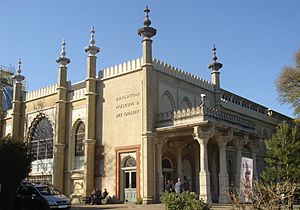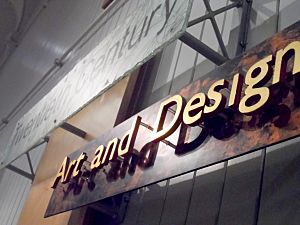- This page was last modified on 17 October 2025, at 10:18. Suggest an edit.
Brighton Museum & Art Gallery facts for kids
 |
|

Brighton Museum & Art Gallery building.
|
|
| Lua error in Module:Location_map at line 420: attempt to index field 'wikibase' (a nil value). | |
| Established | 1805 |
|---|---|
| Location | Brighton, East Sussex, England |
The Brighton Museum & Art Gallery is a cool place to visit in Brighton and Hove, England. It's a public museum and art gallery owned by the city. You can find it in the South East of England. It's part of a bigger group called Brighton & Hove Museums. A yearly pass costs £9.50, but if you live in Brighton or are a local student, it's only £7.
Contents
Discover Brighton Museum & Art Gallery
This museum is packed with amazing things to see. You can explore art, history, and even nature. It's a great spot to learn about Brighton's past and discover treasures from around the world.
A Look at Its Past
The building itself has a long and interesting story. It was once part of the Royal Pavilion Estate.
From Royal Palace to Public Museum
The building was first finished in 1805. It was built for the Prince of Wales, who later became King George IV. He originally planned for it to be a tennis court. However, it was never used for tennis. Instead, it became a place for cavalry soldiers to stay.
After King George IV passed away in 1830, King William IV also stayed at the Pavilion. But by 1845, Queen Victoria decided she didn't want to visit Brighton anymore. The government then planned to sell the Royal Pavilion and its grounds.
Luckily, the people of Brighton wanted to keep it. They asked the government to sell it to the town. In 1850, Brighton bought the Pavilion for £53,000. That was a lot of money back then!
Soon after, in 1851, parts of the Pavilion started hosting art shows. Local artists showed their work there. The museum and art gallery moved into its current spot in the building in 1902.
A Modern Makeover
In 2002, the museum and art gallery had a huge makeover. It cost £10 million to make it even better! After this, the main entrance changed. What used to be the museum's entrance became the entrance for the Brighton Dome. The Dome is a place where live shows and concerts happen.
More Museums to Explore
The Brighton Museum & Art Gallery is just one of several cool places. It's part of Brighton & Hove Museums, which also includes:
- The beautiful Royal Pavilion
- The Booth Museum, full of natural history
- The Hove Museum of Creativity
- The historic Preston Manor
What's Inside: Amazing Collections
The museum has many different collections. They cover everything from ancient history to modern art.
Art and Design Treasures
The Decorative Art collection shows off British, European, and American art. It includes items from the 1600s to today. You can see ceramics, glass, metalwork, furniture, and jewellery. There are also modern crafts.
Nature's Wonders
The Natural Sciences collection is all about nature. It has the Edward Booth collection of British Birds. You can also find many other animals and rocks. There are even half a million insects, including lots of butterflies!
Stories from Around the World
The World Art collection holds 15,000 objects. These come from Africa, Asia, the Pacific, and the Americas. One special part is from James Henry Green. He collected items from Burma in the 1920s and 1930s.
Fine Art Masterpieces
The Fine Art Collection features sculptures, paintings, and drawings. These pieces date from the 1400s to the 1900s. You can see works by famous European artists. There are also American paintings from the 20th century. Some items were given by Edward James, who collected surrealist art.
Fashion Through Time
The Costume and Textile collection displays clothes and accessories. These are from Britain, Europe, and North America. They show fashion from the 1700s to today.
Toys and Games Galore
The Toy collection is full of toys, dolls, and games. They range from the 1700s to now. It started with the National Toy Museum. This collection has over 20,000 items!
Early Film Magic
The Film and Media collection has old equipment. It shows how early movies were made in England from 1896 to 1930. You can see magic lantern projectors and early filmmaking tools.
Brighton's Own History
The Local and Social History collection tells Brighton's story. It has objects, photos, and recordings of people's memories. These show what life was like in Brighton & Hove from the 1700s to today.
Ancient Discoveries
The Archaeology collection includes items found in Brighton & Hove. It also has a large collection from ancient Egypt.
Royal Pavilion Secrets
The Royal Pavilion collections include original furniture and items. These belonged to King George IV. They also have old records about the building itself.
Some of these collections are "Designated collections." This means experts have said they are really important. They are important not just for Britain, but for the whole world!
Must-See Exhibits
Here are some of the coolest things you can discover at the museum:
King George IV's Breeches
You can see a pair of breeches worn by King George IV. Breeches were a type of short trousers. These green wool breeches were made in 1827. By 1810, longer trousers were becoming popular. But King George IV loved his breeches! He even banned trousers from his court until 1815.
The First Colour Film Camera
Check out a Kinemacolor camera from around 1910. Kinemacolor was a special technique. It was the first way to make colour films that people could actually watch. It was invented by George Albert Smith. He was one of the first movie pioneers in Brighton & Hove.
Art from Clarice Cliff
There's a beautiful wall plaque made between 1934 and 1939. It shows scenes from Imperial India. The famous artist Clarice Cliff designed it. She used ideas from larger artworks by Frank Brangwyn.
Lewis Carroll's Tiny Toolbox
See a toy toolbox with miniature tools. It has a tiny mallet, corkscrew, and screwdriver. The lid says '1846 Toolbox ELD from CLD'. It was made by Charles Lutwidge Dodgson. You might know him better as Lewis Carroll, the author of Alice in Wonderland!
An Ancient Egyptian Portrait
Discover a portrait painted with coloured beeswax. It was found on a mummified body in Egypt. This portrait is from the 2nd century. The white robes show that the person was important. They were part of the rich Roman families living in Egypt.
Magical Water Puppets
The museum has Vietnamese water puppets from the mid-1900s. These puppets are carved from wood and hand-painted. Water makes the puppets seem to float and hides the strings. Teu is the main puppet. He introduces other characters who tell their own stories. This art form was once a secret, passed down from father to son.
Edward Booth's Bird Collection
See Edward Thomas Booth's hunting outfit. It includes leather boots, a hat, and a gun. Booth collected many British birds. He opened his bird museum in 1874. He wanted to show one example of every British bird species. He traveled all over the country to find them.
A Historic Drinking Cup
There's a drinking beaker made from horn. It's from the early 1800s. Back then, Brighton had many inns. The cup has a faint message: 'Greyhound Inn Brighton, 1821'. The Greyhound Inn was a famous spot in Brighton.
The Mysterious Hove Amber Cup
Don't miss the Hove amber cup. It's one of Britain's most important finds from the Bronze Age. It was found in 1856 when workers were digging for a new road. Inside a burial mound, they found an oak coffin. It held bone pieces, a dagger, and an axe head. But the most amazing find was the Amber Cup. It was made from a single piece of amber!


